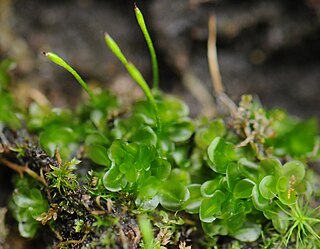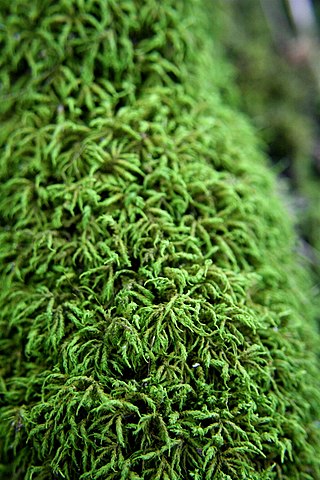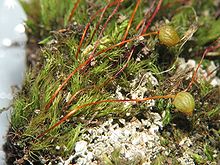
Buxbaumia is a genus of twelve species of moss (Bryophyta). It was first named in 1742 by Albrecht von Haller and later brought into modern botanical nomenclature in 1801 by Johann Hedwig to commemorate Johann Christian Buxbaum, a German physician and botanist who discovered the moss in 1712 at the mouth of the Volga River. The moss is microscopic for most of its existence, and plants are noticeable only after they begin to produce their reproductive structures. The asymmetrical spore capsule has a distinctive shape and structure, some features of which appear to be transitional from those in primitive mosses to most modern mosses.

Johann Hedwig, also styled as Johannes Hedwig, was a German botanist notable for his studies of mosses. He is sometimes called the "father of bryology". He is known for his particular observations of sexual reproduction in the cryptogams. Many of his writings were in Latin, and his name is rendered in Latin as Ioannis Hedwig or Ioanne Hedwig. The standard author abbreviation Hedw. is used to indicate this person as the author when citing a botanical name.

Andreaea is a genus of rock mosses described by Johann Hedwig in 1801.

Oedipodium is the only genus of moss in the family Oedipodiaceae. It contains the single species Oedipodium griffithianum, the gouty-moss or Griffith's oedipodium moss. This species is distributed in cooler climates of Eurasia, as well as from Alaska, Washington state, British Columbia, Yukon, Greenland, Newfoundland, Tierra del Fuego and the Falkland Islands.

Tetraphidaceae is a family of mosses. It includes only the two genera Tetraphis and Tetrodontium, each with two species. The defining feature of the family is the 4-toothed peristome.

Timmia is a genus of moss. It is the only genus in the family Timmiaceae and order Timmiales. The genus is named in honor of the 18th-century German botanist Joachim Christian Timm.

Christian Friedrich Hornschuch was a German botanist.
KarlJohannAugustMüller was a German bryologist and science popularizer.

Entodon seductrix, known as the seductive entodon moss or round-stem silk moss, is a species of Entodontaceae.

Grimmia is a genus of mosses (Bryophyta), originally named by Jakob Friedrich Ehrhart in honour of Johann Friedrich Carl Grimm, a physician and botanist from Gotha, Germany.

Bartramia pomiformis, the common apple-moss, is a species of moss in the Bartramiaceae family. It is typically green or glaucous in hue, although sometimes it can appear yellowish. The stems extend from a half cm to 8 cm, with narrowly lanceolate to linear-lanceolate leaves 4 – 9 mm long. The leaves have a nerve and are toothed. They are curled when dry but stick out when moist.
Christian Friedrich Schwägrichen was a German botanist specializing in the field of bryology.

Racomitrium lanuginosum is a widespread species of moss found in montane and arctic tundra, the genus Racomitrium is found across the Northern and Southern hemispheres., however Racomitrium lanuginosum is only found in the Northern hemisphere. It grows as large mats on exposed rock and in boulder scree, particularly on acidic rocks. Its leaves have a characteristically decurrent and toothed hair-point, which gives rise to its regional common names woolly fringemoss, hoary rock-moss and woolly moss.

Cyathophorum bulbosum, commonly known as quill moss or the false fern moss, is found in the eastern states of Australia as well as Papua New Guinea, New Zealand, Auckland Islands, Chatham Island, Lord Howe Island and possibly Norfolk Island and New Ireland.

Aulacomnium is a genus of mosses of the family Aulacomniaceae, with a circumpolar distribution.

Pohlia is a genus of mosses in the family Mniaceae, found on all continents including Antarctica. Some of its species are native to multiple continents. The center of diversity is the Northern Hemisphere.

Meesia is a genus of mosses belonging to the family Meesiaceae. The genus has cosmopolitan distribution.

Neckera is a large genus of mosses belonging to the family Neckeraceae. The genus was first described by Johann Hedwig. The genus has a cosmopolitan distribution.

Rhynchostegium is a genus of pleurocarpous mosses belonging to the family Brachytheciaceae. The genus has a cosmopolitan distribution across different climatological regions except the polar regions, mostly in tropic to north temperate regions. The genus contains both aquatic and terrestrial species. The genus was named for their rostrate opercula. The type species of this genus is Rhynchostegium confertum (Dicks.) Schimp.

















